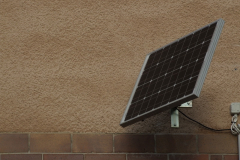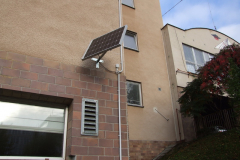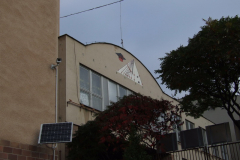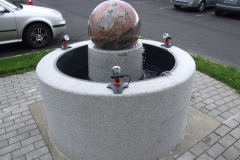Fountain with revolving ball powered by solar energy
In a stone bed (mastered exactly according to the curvature of the sphere), there is a polished marble ball with a diameter of 40 cm gently turning on the water flow and thus creating a stunning effect.
At first glance, we could assume that the ball is hollow and lightweight. In fact, the manufacturing of such a perfect hollow sphere is technically unrealistic, the ball is solid and surprisingly heavy – its mass is about three quarters of a ton!

We will obtain the weight of a sphere as the product of its density (for marble it is 2,800 kg/m-3) and volume: m = . V = . 4/3 r3 = 2,800 kg.m-3. 4/3 . 3.14 . (0.4 m)3= 750 kg.
However even such heavy stone ball is surprisingly easy to rotate in all directions, even a child can easily stop it with its palm or, contrary to that, speed up the spin.
The operation is based on the famous Archimedes‘ principle, respectively the combined effects of hydrostatic and hydrodynamic pressure of flowing water.

Any object immersed in a liquid (fluid or gas) is buoyed up by a force equal to the weight of the liquid of the same volume as the immersed part of the body.
Even the high surface tension of water plays its role.

The surface of the liquid behaves as if it was made up of a very thin elastic layer (like an elastic film) that seeks to withdraw the surface of the liquid so that at the given volume of liquid it covers the smallest area (the surface of the fluid is actually trying to achieve a state of lowest energy) .Surface tension causes some types of insects (eg water measurers) can move on water.
In fact, the ball floats and glides on a thin layer of water. The necessary layer of water is created by a hidden pump that brings a small stream of the liquid from the bottom tank into the ball-shaped subsoil bed. Due to the relatively large area of the submerged sphere there is a relatively small pressure required.


The submerged portion of the sphere has the surface of a spherical cap shape whose radius equals the distance (2 + v2) of the top of the canopy from its circular edge, Ie. Sv = p(2 + v2) = 2rv.
Note: The surface area of the whole sphere is equal to four times the area of its largest circle (S = 4r2). If we Estimate the ball is submerged to about 5 cm (ie, v = 0.05 m), the submerged area is Sv = 2rv = 2×3.14×0.4×0.05 = 0.125 m2 = 1,250 cm2.
The common pressure in water pipes is a about 0.25 MPa, ie 250,000 N/m2 = 250,000 N/10,000 cm2 = 25 N/cm2 (which roughly corresponds to the weight of 2.5 kg/cm2). The pressure force of 25 N acts on each of the 1,250 cm2. The water that fills the gap of barely a millimeter can bear the weight of more than 30,000 N (just 1,250×25 N), ie a ball weighing more than 3,000 kg = 3 tons!
The star called the Sun
The Sun (a huge glowing sphere made up mainly of hydrogen) is distanced from the Earth at about 150 million km. The solar beam travels this distance in 8 minutes and 20 seconds. In the center of the Sun, hydrogen particles suddenly and often collide and coalesce at huge temperature (13 million K) and pressures (20 billion MPa) in a new helium core – so hydrogen is changing into helium while huge energy is released.
Every second during this so-called thermonuclear reaction around half a billion tons of hydrogen turn into helium. At the same time, there are 3.8×1026
joules of energy (ie the power of 3.8×1026 W) released. A mere two-billionth of this total energy radiated by the Sun hits the Earth (moreover, one third of the benefit is reflected back into space), though all life on Earth depends on it. The energy of all living organisms, moving air, rivers and ocean currents, in thought and in the muscles, the smile and mammoth machines – these are actually just some examples of different forms of the same energy, released in the sun.
From the amount of helium and hydrogen it has been calculated that the Sun has been shining for almost 5 billion years and will still be shining for the next 10 billion years.

Within our terms, about 1200 kWh of solar energy fall on every square meter of landscape, roof surface, vegetation, roads, or water level in one year on average, which is comparable to the amount of energy released by burning 250 kg of coal. An electrified household consumes 15 to 20 MWh, ie as many as hits less than 20 m2 per year.

Source:http://www.bramac.cz/fileadmin/rootBramac/bramac_czech/Produkte/Bilder/Solar/slunecni_energie.jpg
The large cube represents the energy hitting the earth in one year. The smaller cube symbolizes the available energy reserves on the planet and the smallest cube shows the global annual energy needs.
Various devices have been developed to use solar energy, the most abundant, cleanest, cheapest („fuel“ is for free), and (within the limits of human time scales) inexhaustible form of energy. Our planet Earth is the target of an average of 89 000 TW (terawatt) of solar energy, which is many thousand times more than the needs of all humanity with its advanced technology. The future belongs to the Sun!
Electricity from solar radiation
Direct conversion of sunlight into electricity is done via the photovoltaic effect

Negative electrons are emitted from thin wafers of some semiconductors (eg silicon) by incident light particles, thus being separated from positive charges. This creates a voltage. A successive connection of the lit and unlit side of the plate with a wire makes the free electrons return – we get electricity.
Solar cell made of monocrystalline silicon slice
Burning fossil fuels (coal, oil, gas) we use the energy accumulated in recent geological times by photosynthesis to a maximum efficiency of 1%. These resources were formed millions of years, but our civilization will dispose of them for no more than a few hundred years to come.
We must extract, process and bring the fossil fuels to the consumer. By their combustion, we use solar energy with an efficiency of less than one per mille. Solar collectors are working with several tens of percent efficiency all year round.
The sun will still warm our planet at a comfortable temperature for at least 10 billion years. To every square meter of our territory it sends a yearly energy equivalent of two and a half tons of coal. Thus solar energy is a deal.

Source: http://apod.nasa.gov/apod/image/1104/arp273_hst.jpg
Picture of the Hubble Space Telescope placed in orbit around Earth.
Cosmic Fountain
A cosmic portrait of two beautiful galaxies (clusters of hundreds of billions of stars) that are far beyond our galaxy (Milky Way)at a distance of over 300 million light years. Their warped look like a fountain jet is caused by mutual gravitational forces during close stellar encounters of both star islands (nuclei of both galaxies separated astronomically seen just by 100 000 light years).
The radial stars in the foreground of this cosmic portrait are inside our own Milky Way.






